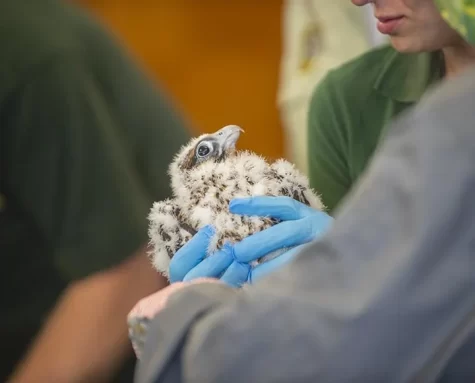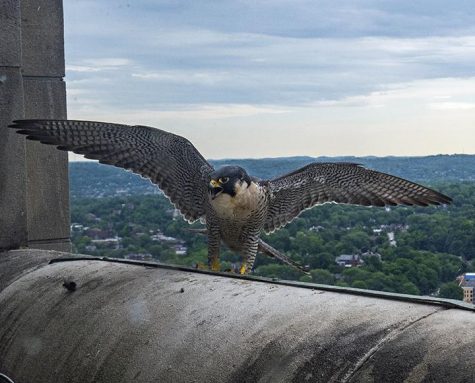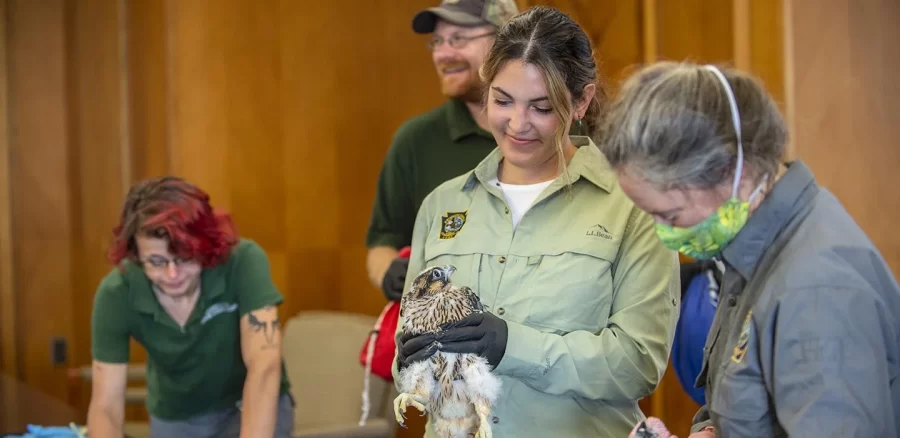Peregrine falcons receive bands for first time since pandemic
One of Pitt’s three baby peregrine falcons receives a band in the Cathedral of Learning on Thursday.
September 23, 2022
When Kate St. John first noticed a pair of peregrine falcons arrive at Pitt in 2001, she immediately emailed the PA Game Commission (PGC) out of excitement. A rare sight to see, St. John set out to get a nest box installed at the Cathedral of Learning.
“I worked with the game commission, Pitt and the Western Pennsylvania Conservancy to get a box up there for the 2002 season,” St. John, author of the popular blog “Outside My Window,” said. “They’ve nested successfully almost every year and have been here nonstop since 2001. Now we’re on our third pair.”
Pitt’s three peregrine falcon chicks received their bands in May 2022, a tradition that has not occurred since before the COVID-19 pandemic. Banding is when birds are tagged with small metal bracelets that track and account for the birds throughout their lives, according to a Pittwire article.

(Image via Pittwire )
According to St. John, the peregrine falcon became extinct east of the Mississippi by the late 1960s and placed on the endangered species list in 1970. She said dichlorodiphenyltrichloroethane (DDT) – a chemical widely used during WWII – was repurposed as an insecticide after the war. DDT is a “persistent chemical” and builds up within an organism the more that it is exposed to it, whether directly or through consuming its prey, according to St. John.
St. John said due to the peregrine’s top spot on the food chain, the bioaccumulation of DDT caused an interference with the deposition of calcium in their eggshells.
“They laid eggs, but the shell was so thin that when they sat on the eggs they cracked and the embryos died,” St. John said. “After the lifespan of all existing adult peregrines, there weren’t any more.”
St. John said at the beginning of the recovery program in the 1970s, “people who loved peregrines” worked with wildlife agencies and falconers to breed them in captivity. According to St. John, upon the peregrine’s release, they received bands to track their location because so few existed at the time.
In a blog post from May 26, St. John explained that this year was the first time Morela and Ecco, the two adult peregrines residing in the Cathedral of Learning nest, had their chicks banded. Morela did not have chicks in 2020, and the PGC conducted “no/few” peregrine bandings in 2021.
The three chicks received health checks and were weighed to determine their sex, one being male and the other two females, according to St. John’s blog post. Each chick received two leg bands, a black and green band that’s visible through binoculars and a silver U.S. Fish and Wildlife service band. An endangered bird biologist from the PGC conducted the banding and placed a colored piece of tape on the USFW band, red for the male and yellow for the females, which is visible on the nest camera and in photos, according to St. John’s post.
The male chick left the nest around June 17, according to St. John, and was found dead on June 28 at the county airport. She said this is an example of the benefits of banding, as there would be no record of this if he hadn’t gotten his bands.
Shortly after the installation of the nest box at the Cathedral, the WPC installed a nest camera at the site in 2003, according to St. John. The National Aviary hosts a livestream of the nest every spring and summer.

(Image via Pittwire )
Robert Mulvihill, the staff ornithologist at the National Aviary, said the nest camera provides people with a direct connection to the falcons and “inspires respect for nature.” He said it provides an opportunity to view wild birds very close-up, the same way one could at the National Aviary.
“It’s very hard to convince anyone to take action or support programs pertaining to conservation without that direct connection to the bird,” Mulvihill said. “We think that they’re a very effective way to cultivate that appreciation for nature generally.”
St. John said most peregrine falcon banding has ceased in PA because peregrines are no longer endangered or threatened. The PGC now only bands peregrine falcons at “two or three” sites throughout all of PA, and the Cathedral of Learning is one of them, according to St. John.
“Most peregrines that nest on structures are choosing bridges, and that requires a lot of work,” St. John said. “The relationship with the University of Pittsburgh is really good, it’s an iconic building, and it’s relatively easy to band at Pitt compared to other sites.”
Garrett Sisk, the president of Pitt’s Birdwatching and Ornithology Club, said peregrine falcons are world renowned for being the fastest animal on the planet, hitting speeds over 200 mph in their “famous stoop dive.” He also said they often nest on the edge of cliffs and bluffs, preferably near bodies of water or open areas.
“While Cathy may not be a cliff, hopefully you can see the connection between natural cliffs and these man-made, urban nesting locations,” Sisk said.
Sisk said he believes everyone should take a moment to appreciate “how special raptors really are.”
“I have run across so many people that are disgusted with raptors and their methods of catching and consuming prey,” Sisk said. “However, I have found that their power and strength is really stunning, and behind the fearsome look in their eyes, they are just as cute and lovely as a warbler or hummingbird.”



